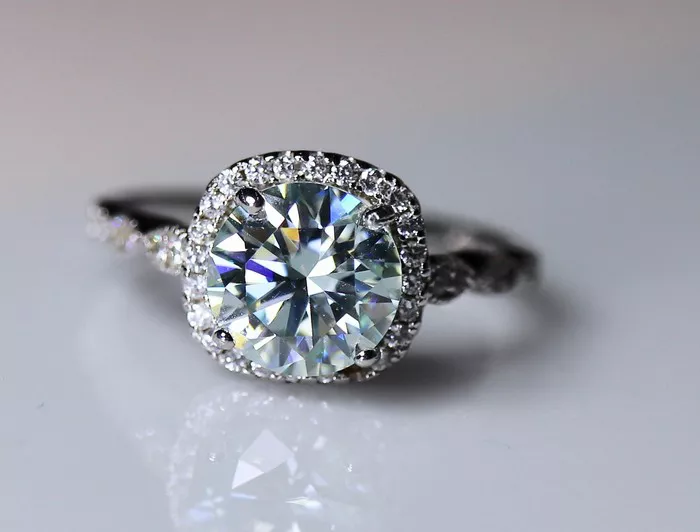Moissanite, a stunning gemstone, has gained immense popularity as a viable alternative to diamonds. Named after Nobel Prize-winning chemist Henri Moissan who discovered it in 1893, moissanite was initially found in a meteor crater in Arizona. However, it wasn’t until the late 20th century that scientists were able to successfully replicate its creation in a laboratory setting. Moissanite has become highly sought after due to its remarkable brilliance, durability, and ethical sourcing, making it an appealing choice for those seeking an environmentally conscious and cost-effective alternative to traditional diamonds.
Physical Properties
Understanding the physical properties of moissanite is crucial in determining its authenticity. One of its standout features is its exceptional hardness, ranking 9.25 on the Mohs scale, just slightly below diamonds, making it highly resistant to scratching and abrasion. This durability ensures that moissanite jewelry maintains its brilliance and luster over time, making it an excellent choice for everyday wear.
Another distinguishing characteristic of moissanite is its double refraction properties. Unlike diamonds, which have single refraction, moissanite exhibits double refraction, meaning light entering the stone is split into two separate rays. This unique optical trait results in increased brilliance and fire, giving moissanite its distinctive sparkle.
Visual Inspection Tips
Conducting a visual inspection is an initial step in determining the authenticity of moissanite. Here are some tips to help you assess whether a stone is genuine:
1. Scratch Test: Moissanite’s exceptional hardness makes it highly resistant to scratches. Use a common household item like sandpaper or a metal file to attempt to scratch the stone. If there are no scratches or signs of wear, it’s likely authentic moissanite.
2. Brilliance and Color: Moissanite exhibits exceptional brilliance, often surpassing that of diamonds. Look for vibrant flashes of light as you move the stone under natural or artificial light. Additionally, observe the color of the stone—moissanite typically appears colorless or near-colorless, although some varieties may exhibit a slight yellow or green tint.
3. Lighting Conditions: Examine the stone under various lighting conditions, including natural sunlight, fluorescent, and incandescent light. Authentic moissanite will display consistent brilliance and fire across different lighting environments.
Home Testing Methods
In addition to visual inspection, several home testing methods can help verify the authenticity of moissanite:
1. Double Refraction Test: To perform this test, place the stone on a piece of printed text or a grid pattern. When viewed through the stone, you’ll notice a doubling effect, where the text or pattern appears slightly blurred or duplicated. This phenomenon is characteristic of moissanite due to its double refraction properties.
2. UV Light Test: Moissanite exhibits strong fluorescence under ultraviolet (UV) light. Using a UV flashlight, shine the light onto the stone and observe any fluorescence. Authentic moissanite will emit a blue or green glow, confirming its genuineness.
3. Use of Tools: Consider using a diamond tester pen, a portable device designed to differentiate between diamonds and other gemstones. While moissanite may register as diamond-like on certain testers, advanced models can accurately identify moissanite based on its electrical conductivity. Interpret the results accordingly, noting any indications of moissanite or diamond presence.
Precautions
While conducting home tests, it’s essential to exercise caution to avoid damaging the stone or jewelry. Avoid using harsh chemicals or abrasive materials that could scratch or tarnish the surface of the stone. Additionally, handle the jewelry with care to prevent accidental breakage or loss.
Professional Verification
If uncertainty persists regarding the authenticity of moissanite, consider seeking professional verification from a reputable jeweler or gemologist. These experts possess the knowledge and specialized equipment necessary to accurately assess the authenticity of gemstones, providing peace of mind and assurance regarding your purchase.
Conclusion
In conclusion, being able to distinguish between real and synthetic moissanite at home is a valuable skill for consumers seeking quality gemstones. By understanding moissanite’s unique physical properties and employing visual inspection and home testing methods, individuals can confidently identify genuine moissanite jewelry. Additionally, exercising caution and seeking professional verification when necessary ensures accurate assessment and enhances the overall purchasing experience. With its remarkable brilliance, durability, and ethical sourcing, moissanite continues to captivate jewelry enthusiasts as a compelling alternative to traditional diamonds.

